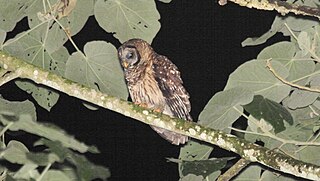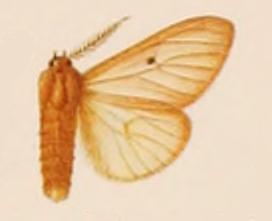
The fulvous whistling duck or fulvous tree duck is a species of whistling duck that breeds across the world's tropical regions in much of Mexico and South America, the West Indies, the southern United States, sub-Saharan Africa and the Indian subcontinent. It has plumage that is mainly reddish brown, long legs and a long grey bill, and shows a distinctive white band across its black tail in flight. Like other members of its ancient lineage, it has a whistling call which is given in flight or on the ground. Its preferred habitat consists of wetlands with plentiful vegetation, including shallow lakes and paddy fields. The nest, built from plant material and unlined, is placed among dense vegetation or in a tree hole. The typical clutch is around ten whitish eggs. The breeding adults, which pair for life, take turns to incubate, and the eggs hatch in 24–29 days. The downy grey ducklings leave the nest within a day or so of hatching, but the parents continue to protect them until they fledge around nine weeks later.

The angle shades is a moth of the family Noctuidae. The species was first described by Carl Linnaeus in his 1758 10th edition of Systema Naturae. It is distributed throughout Europe as far east as the Urals and also in the Azores, in Algeria, and in Asia Minor, Armenia, and Syria. It is strongly migratory.

The fulvous owl, or Guatemala barred owl, is a resident of the cloud forests of Central America. A medium-sized true owl, it has a round head, lacking ear tufts. Typical coloration is warm dark brown or reddish brown on the back and lighter brown on the front with darker barring. Adults weigh approximately 600 grams (21 oz), with females being heavier. Its distribution is limited to highland regions of Guatemala, Honduras, and El Salvador. It inhabits elevations from 1,200 to 3,100 meters, and is fairly common within its range. Its behavior is poorly known, as are its population size and distribution. It is classified as a species of least concern by the International Union for Conservation of Nature, although it is considered endangered in Mexico.
The fulvous harvest mouse is a species of rodent in the family Muridae. It is found in El Salvador, Guatemala, Honduras, Mexico, Nicaragua, and the United States.

Helotropha leucostigma, the crescent, formerly Celaena leucostigma is a moth of the family Noctuidae. It is found in the Palearctic realm.

Mesapamea secalis, the common rustic, is a moth of the family Noctuidae. The species was first described by Carl Linnaeus in his 1758 10th edition of Systema Naturae. It is found in Europe, north-west Africa, Turkey and northern Iran.

Spilosoma pellucida is a moth of the family Erebidae. It was described by Walter Rothschild in 1910. It is found in Ghana.

Photedes captiuncula, the least minor, is a moth of the family Noctuidae. It is found throughout Europe, in Turkey, Armenia, Russia and much of temperate Asia.
Pandemis perispersa is a moth of the family Tortricidae. It is found in north Madagascar.
Margarosticha gaudialis is a moth in the family Crambidae. It was described by George Hampson in 1917. It is found in Papua New Guinea.
Chilo ceylonica is a moth in the family Crambidae. It was described by George Hampson in 1896. It is found in Sri Lanka, Vietnam and Hainan, China.
Acropentias papuensis is a moth in the family Crambidae. It was described by George Hampson in 1919. It is found in New Guinea.
Patania hemipolialis is a moth in the family Crambidae. It was described by George Hampson in 1918. It is found in Colombia.
Pilocrocis fulviflavalis is a moth in the family Crambidae. It was described by George Hampson in 1917. It is found in Peru.
Sameodes furvipicta is a moth in the family Crambidae. It is found in Papua New Guinea.
Syllepte diacymalis is a moth in the family Crambidae. It was described by George Hampson in 1912. It is found in Mexico (Morelos), Guatemala and Costa Rica.
Ambia cymophoralis is a moth in the family Crambidae described by George Hampson in 1917. It is found on St Aignan Island in the Louisiade Archipelago of Papua New Guinea.
Striginiana strigina is a moth in the family Eupterotidae. It was described by Westwood in 1849. It is found in Cameroon, the Republic of Congo, Gabon, Sierra Leone, Tanzania and Uganda.
Streblote dorsalis is a moth of the family Lasiocampidae first described by Francis Walker in 1866. It is found in India, Sri Lanka, the Philippines, Borneo, Indonesia and Java.
Age onychistica is a moth of the family Tortricidae first described by Alexey Diakonoff in 1982. It is found in Sri Lanka, It is also found in Africa and Indonesia.





